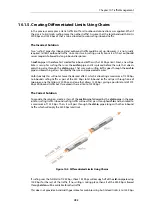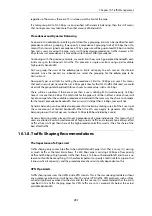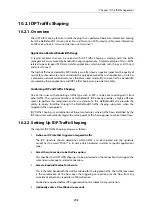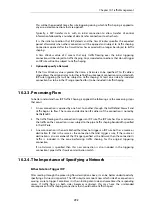
and 23, respectively:
Keep the forward chain of both rules as std-out only. Again, to simplify this example, we
concentrate only on inbound traffic, which is the direction that is the most likely to be the first
one to fill up in client-oriented setups.
Set the return chain of the port 22 rule to ssh-in followed by std-in.
Set the return chain of the port 23 rule to telnet-in followed by std-in.
Set the priority assignment for both rules to Use defaults from first pipe; the default
precedence of both the ssh-in and telnet-in pipes is 2.
Using this approach rather than hard-coding precedence 2 in the rule set, it is easy to change the
precedence of all SSH and Telnet traffic by changing the default precedence of the ssh-in and
telnet-in pipes.
Notice that we did not set a total limit for the ssh-in and telnet-in pipes. We do not need to since
the total limit will be enforced by the std-in pipe at the end of the respective chains.
The ssh-in and telnet-in pipes act as a "priority filter": they make sure that no more than the
reserved amount, 64 and 32 Kbps, respectively, of precedence 2 traffic will reach std-in. SSH and
Telnet traffic exceeding their guarantees will reach std-in as precedence 0, the best-effort
precedence of the std-in and ssh-in pipes.
Note: The return chain ordering is important
Here, the ordering of the pipes in the return chain is important. Should
std-in
appear
before
ssh-in
and
telnet-in
, then traffic will reach
std-in
at the lowest precedence only
and hence compete for the 250 Kbps of available bandwidth with other traffic.
10.1.7. Pipe Groups
NetDefendOS provides a further level of control within pipes through the ability to split pipe
bandwidth into individual resource users within a
group
and to apply a limit and guarantee to
each user.
Individual users can be distinguished according to one of the following:
•
Source IP
•
Destination IP
•
Source Network
•
Destination Network
•
Source Port (includes the IP)
•
Destination Port (includes the IP)
•
Source Interface
•
Destination Interface
This feature is enabled by enabling the
Grouping
option in a pipe. The individual users of a group
can then have a limit and/or guarantee specified for them in the pipe. For example, if grouping is
done by source IP then each
user
corresponds to each unique source IP address.
Chapter 10: Traffic Management
788
Содержание NetDefendOS
Страница 30: ...Figure 1 3 Packet Flow Schematic Part III Chapter 1 NetDefendOS Overview 30 ...
Страница 32: ...Chapter 1 NetDefendOS Overview 32 ...
Страница 144: ...Chapter 2 Management and Maintenance 144 ...
Страница 220: ... Enable DHCP passthrough Enable L2 passthrough for non IP protocols 4 Click OK Chapter 3 Fundamentals 220 ...
Страница 267: ... SourceNetwork lannet DestinationInterface any DestinationNetwork all nets 4 Click OK Chapter 3 Fundamentals 267 ...
Страница 284: ...Chapter 3 Fundamentals 284 ...
Страница 360: ...The ospf command options are fully described in the separate NetDefendOS CLI Reference Guide Chapter 4 Routing 360 ...
Страница 392: ...Chapter 4 Routing 392 ...
Страница 396: ...Web Interface 1 Go to Network Ethernet If1 2 Select Enable DHCP 3 Click OK Chapter 5 DHCP Services 396 ...
Страница 419: ... Host 2001 DB8 1 MAC 00 90 12 13 14 15 5 Click OK Chapter 5 DHCP Services 419 ...
Страница 420: ...Chapter 5 DHCP Services 420 ...
Страница 424: ...2 Now enter Name lan_Access Action Expect Interface lan Network lannet 3 Click OK Chapter 6 Security Mechanisms 424 ...
Страница 573: ...Chapter 6 Security Mechanisms 573 ...
Страница 575: ...This section describes and provides examples of configuring NAT and SAT rules Chapter 7 Address Translation 575 ...
Страница 607: ...Chapter 7 Address Translation 607 ...
Страница 666: ...Chapter 8 User Authentication 666 ...
Страница 775: ...Chapter 9 VPN 775 ...
Страница 819: ...Chapter 10 Traffic Management 819 ...
Страница 842: ...Chapter 11 High Availability 842 ...
Страница 866: ...Default Enabled Chapter 13 Advanced Settings 866 ...
Страница 879: ...Chapter 13 Advanced Settings 879 ...
















































